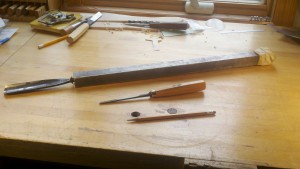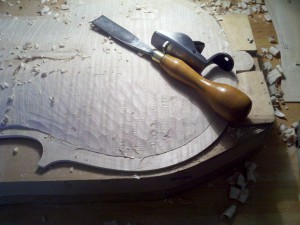
Carving an arching from a solid piece of maple starts out as a very physical job. I have always enjoyed the challenge of removing wood in large chunks of wood with a big gouge, and the thrill of danger adds to the experience. The gouge is mounted on a heavy 20 inch handle of solid steel, the weight and momentum helping me do the work. And an awareness of the damage that 6 pounds of steel ending in a razor-sharp edge could do in a careless moment to the instrument – or me- is a constant companion.
“Call me Ishmael” always pops into my head when I unpack this harpoon from its resting place. It has no other use than in rough arching and I like to fancy Queequeg hefting it and considering it thoughtfully. It dwarfs every other carving tool in my shop and I love using it, despite its ungainly square handle. It was meant to be a temporary experiment, replaced with a rounded handle, but I grew fond of its oddness.
I never start quickly with this tool, starting with tentative nibbling at the maple. Soon enough I find myself in tune with it once again, and am able to make large bold cuts of great precision and delicacy. This is deeply satisfying.
Making a blank slab of hard wood into an instrument that will sing for hundreds of years to come is a delightful idea, yet to me something more elemental is happening at this stage of the work. There is an earthy relish to hewing away confidently at the untamed material, outlining the shape which later will be refined into the flowing grace of a beautiful arching. Before I wish it, the moment comes when I must switch to a smaller gouge and small planes to refine the shapes which have been sketched out.
